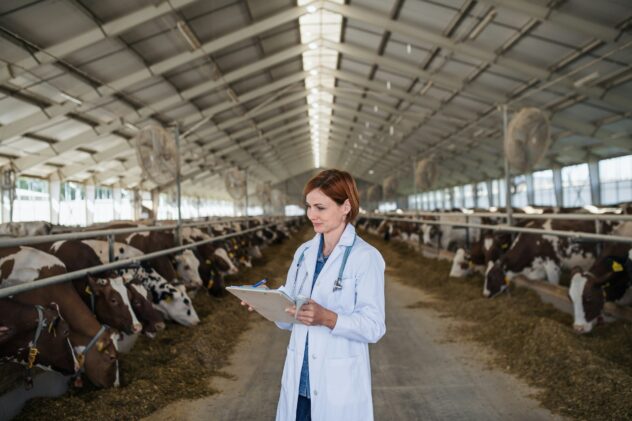
As a physician, I often emphasize the importance of staying informed without succumbing to unnecessary panic, especially when it comes to food safety. Recently, news of an avian influenza (H5N1) outbreak affecting dairy cattle in nine American states has caused a stir among milk drinkers. Understandably, people are concerned about the safety of milk products in light of these findings.
Here’s what we know:
- Remnants of the H5N1 virus were detected in about 20% of pasteurized milk samples tested by the FDA. This revelation might sound alarming at first glance, but it’s crucial to understand what these findings mean.
- Rigorous testing, including egg inoculation studies, has shown no evidence of live H5N1 virus in pasteurized milk. This confirms what experts have long known: the pasteurization process effectively neutralizes harmful pathogens, including avian influenza.
As Michael Payne, a researcher at the Western Institute of Food Safety and Security, aptly put it to the BBC, “Pasteurisation equals safety.” For consumers who opt for pasteurized dairy products, the consensus among food safety experts remains reassuring: your milk is safe to drink. However, it’s also a stark reminder of the risks associated with raw, unpasteurized milk, which has always been a gamble—and even more so now with avian influenza circulating.
Understanding H5N1 and Its Impact on Milk
The avian influenza virus, commonly referred to as H5N1 is typically associated with birds, but its recent emergence in dairy cattle has raised questions about its implications for milk production and safety. While this development is notable, understanding the facts behind the headlines is essential to addressing consumer concerns.
H5N1 has been detected in dairy cattle across nine American states, sparking an investigation into whether the virus might compromise milk safety. The FDA, acting with commendable diligence, tested 297 commercial dairy products from 38 states, including pasteurized milk. Their findings revealed viral remnants in approximately 20% of pasteurized milk samples.
This statistic, while initially concerning, is not a cause for alarm. Follow-up egg inoculation studies demonstrated that pasteurization effectively neutralizes the virus. No evidence of live H5N1 virus was found in any pasteurized samples, reinforcing the safety of pasteurization as a critical step in milk processing.
As an FDA spokesperson stated, “The FDA has been working with deliberate speed on a wide range of studies looking at milk along all stages of production – on the farm, during processing, and on retail shelves – to inform our understanding of HPAI and its presence in milk.” This rigorous approach reflects the agency’s commitment to ensuring food safety at every stage of the supply chain. Consumers can take comfort in knowing that their pasteurized milk is not only safe but continues to meet the highest standards of public health oversight.
Why Pasteurization Matters
When it comes to milk safety, pasteurization is the gold standard. This process, which involves heating milk to a specific temperature for a set period, effectively destroys harmful bacteria and viruses, including H5N1. As Michael Payne, a researcher at the Western Institute of Food Safety and Security, succinctly stated, “Pasteurisation equals safety.” This isn’t just a slogan; it’s a scientifically proven fact that underscores the importance of this critical step in milk processing.
The recent detection of H5N1 remnants in pasteurized milk samples might raise eyebrows, but experts agree that the pasteurization process inactivates the virus entirely, making pasteurized milk safe for consumption. Egg inoculation studies confirmed that no live H5N1 virus could survive the heating process, providing further reassurance to consumers.
On the other hand, the risks associated with consuming raw, unpasteurized milk cannot be overstated. According to a 2022 study, approximately 4.4% of Americans reported drinking raw milk within the previous year. While this might seem like a small number, it represents a significant risk. States that allow raw milk sales experience foodborne illness outbreaks at a rate 3.2 times higher than states that prohibit such sales.
Drinking raw milk has often been compared to “playing Russian roulette,” and with avian influenza now in the mix, the stakes are even higher. For consumers, the choice is clear: sticking to pasteurized milk is the safest option for you and your family.
Also Read: What Type of Meat is Healthiest?
The Risks of Raw Milk
Raw, unpasteurized milk has long been a topic of debate, but the risks associated with its consumption are well-documented. In the context of the recent H5N1 outbreak, these risks have become even more pronounced. Without the protective barrier of pasteurization, raw milk is vulnerable to contamination—not just from avian influenza, but also from a host of other harmful pathogens, such as Salmonella, E. coli, and Listeria.
As Michael Payne aptly stated to the BBC, “Drinking raw, unpasteurized milk has always been playing Russian roulette. With avian influenza circulating, we’ve just added another bullet.” This stark comparison highlights the unpredictability and potential dangers of consuming raw milk, particularly during a time of heightened concern over foodborne illnesses.
Raw milk enthusiasts often tout its purported health benefits, but it’s important to weigh these against the very real risks. Without the pathogen-killing step of pasteurization, the milk remains a potential vehicle for disease transmission, putting consumers—especially children, pregnant women, and immunocompromised individuals—at heightened risk.
The science is clear: raw milk carries inherent dangers that pasteurization is designed to eliminate. For those prioritizing their health and safety, pasteurized milk remains the unequivocal choice.
Addressing Public Concerns
In response to the avian influenza (H5N1) outbreak, the FDA has implemented rigorous research and safety measures to ensure milk products remain safe for consumption. From testing dairy products at every stage of production to analyzing retail samples, the agency’s proactive approach underscores its commitment to protecting public health. As an FDA spokesperson noted, “The FDA has been working with deliberate speed on a wide range of studies looking at milk along all stages of production – on the farm, during processing, and on retail shelves – to inform our understanding of HPAI and its presence in milk.”
While these efforts provide a strong layer of protection, consumers also play a vital role in ensuring their safety. Here are some practical tips to keep in mind:
- Choose Pasteurized Milk Products: Pasteurization remains the most effective safeguard against harmful pathogens, including H5N1. Always confirm that the dairy products you purchase are pasteurized.
- Stay Informed: Knowledge is power. Keep up-to-date with food safety information from reliable sources such as the FDA and the CDC. This ensures you’re aware of any new developments or recommendations related to milk safety.
By combining the FDA’s robust oversight with informed consumer choices, we can collectively mitigate risks and maintain confidence in the safety of our milk supply.
Should You Be Worried?
While the detection of H5N1 remnants in milk has understandably sparked concern, the science is clear: pasteurized milk remains safe for consumption.
Pasteurization effectively neutralizes the virus, providing a reliable safeguard for consumers. However, raw milk poses significant risks and should be avoided, particularly in light of the current outbreak. By choosing pasteurized products and staying informed, you can confidently enjoy dairy without fear.
Rest assured, the FDA and other food safety organizations are actively monitoring and addressing this issue to protect public health.
Explore More: 4 Most Healthy Vegetables for Women
